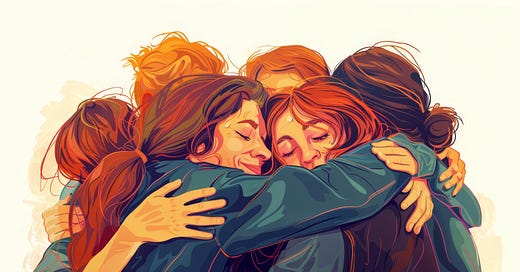Over the last week, a realization has been slowly dawning on me, creeping in through conversations with researchers and HR practitioners at a recent conference, through heart-to-hearts with my coaching clients, and even through my own personal struggles these past few months.
It's a realization that, quite frankly, leaves a bit of a pit in my stomach:
There's a pervasive sense of hopelessness and futility just about everywhere I look.
It's like a heavy fog that's settled over everything and everyone, and it's made me wonder – how much am I contributing to this epidemic of despair? And, perhaps more importantly, how can we turn this tide of negativity into something...well, less soul-sucking?
What is hope?
So, what exactly is hope? Turns out, it's a bit like trying to catch a moonbeam in a jar - slippery and elusive.
The textbook definitions, while helpful, feel a bit dry and clinical. Snyder1, with his Hope Theory, talks about a "positive motivational state" involving "agency" and "pathways." It's all about believing in your ability to take action and find different routes to your goals—willpower meets way power, if you will.
Then there's Herth2, who sees hope as a "multidimensional dynamic life force." It's that confident-yet-uncertain expectation of something good, the belief that it's actually possible, and the knowledge that it matters to you personally. It's a head-and-heart kind of thing.
But newer research is painting an even richer picture. Hope isn't just a static state; it's a dynamic system3, a perceptual process4, even a collective phenomenon5.
I love these advances in thinking. Hope can be how we see the world, adapt to change, and find opportunities amidst challenges. It's the spark that lights our fire, the compass that points toward our true north, and the grit that keeps us going when the going gets tough.
In short, I believe that hope isn't just wishful thinking - it's the very essence of what keeps us moving forward, even when the road ahead seems dark and uncertain.
So, how do we leverage hope in a constructive way? Especially if it feels elusive to us?
Five Perspectives on Hope
As I've been wrestling with these ideas of hope, hopelessness, and the kaleidoscope of roles that hope can play in our lives, I've stumbled upon five perspectives to share.
These are simply my own musings on a concept that I believe is absolutely vital to us all.
I offer them not as definitive answers, but as a gentle nudge, a starting point, perhaps, for your own journey of self-exploration. What does hope mean to you? What does it feel like in your bones? And how can you express it in a way that's true to your own unique spirit?
Perspective 1: Hope as a Muscle, Not a Feeling
Imagine if we approached hope the same way we approach physical fitness.
We wouldn't expect to run a marathon overnight, right? We'd start with small, manageable steps, gradually building up our endurance and strength. Similarly, cultivating hope requires consistent effort and practice. It's about setting realistic goals, even if they seem small at first. It's about taking time each day to visualize positive outcomes, and to remind ourselves of our capabilities and strengths.
And just like any workout, there will be days when it feels hard, when doubt creeps in, and we want to give up.
That's okay. It's part of the process.
But by pushing through those moments, by reminding ourselves that we have the power to shape our own reality, we're strengthening our "hope muscle." We're building the resilience to face whatever challenges life throws our way, knowing that we have the tools to navigate them.
Perspective 2: Hope in the 'Messy Middle'
Life isn't a straight line; it's more like a winding path with unexpected twists and turns. It can be the middle of a book, where the plots haven’t been figured out and things feel like they are in chaos.
Of course, there are moments of joy and triumph, but there are also those in between periods filled with uncertainty, ambiguity, and even loss.
It's in these "messy middles" that hope becomes our most valuable companion, not just when things are bad or good.
When we're in the midst of a career change, a relationship breakup, or a personal crisis, it's easy to feel lost and overwhelmed. Hope, in these moments, isn't about pretending everything's fine. It's about acknowledging the pain and confusion while still holding onto the belief that there's light at the end of the tunnel. It's about trusting that even though we can't see the whole picture yet, we'll eventually emerge on the other side, stronger and wiser for the journey.
Perspective 3: Hope as an Act of Resistance
In a world that often bombards us with negativity, cynicism, and despair, choosing hope can be a revolutionary act. It's a way of refusing to succumb to the darkness, of declaring that we will not be defined by fear or negativity.
Hope isn't about blind optimism or naivete.
Hope is about acknowledging the harsh realities of the world while still believing in the possibility of a better future. It's about recognizing that even in the face of adversity, we have the power to create positive change. When we choose hope, we're not just surviving; we're actively resisting the forces that seek to diminish our spirits.
We're choosing to be agents of light, illuminating the path toward a more just, compassionate, and hopeful world.
Perspective 4: 'Micro-Moments' of Hope
We often think of hope as something grand and epic, something that requires sweeping gestures or dramatic events. But what if hope is actually woven into the fabric of our everyday lives, hidden in plain sight?
It's in the unexpected kindness of a stranger, the warmth of the sun on our face, the sound of a child's laughter…unbridled by the heaviness of life.
Hope is in the simple act of taking a deep breath, savoring a cup of tea, or listening to our favorite song.
These "micro-moments" of hope may seem insignificant on their own, but when we string them together, they create a tapestry of resilience and gratitude. By paying attention to these small moments, we cultivate a sense of wonder and appreciation for the world around us, even in the midst of challenges.
Perspective 5: The Collective Power of Hope
Hope is not just an individual experience; it's a shared energy that connects us all.
When we open up to others about our hopes and dreams, we create a space for vulnerability, understanding, and mutual support.
Sharing our hopes isn't about bragging or seeking validation; it's about recognizing that we're all in this together. It's about creating a community where we can lift each other up, celebrate each other's victories, and offer comfort in times of struggle. The collective power of hope is a force to be reckoned with. It fosters resilience, inspires action, and reminds us that even when we feel alone, we're part of something much bigger than ourselves.
A time for introspection
As we wrap up this little exploration of hope, I invite you to take a deep breath and let these ideas settle in. No need to rush off to conquer the world just yet :). Instead, grab your favorite journal, a cozy blanket, and maybe a cup of tea (or something stronger, if that's more your style), and let's get a little introspective.
Here are some questions to ponder, to scribble about, to let marinate in your soul:
Hope as a Muscle: Think of it like this: hope is less like a mood ring and more like those biceps you've been secretly admiring at the gym (or maybe that's just me?). What small, hopeful actions can you take today to flex those hope muscles? Maybe it's setting a tiny goal, like finally cleaning out that junk drawer, or taking five minutes to visualize your dream vacation. The key is to make it a habit, even when life throws you a curveball (and let's be honest, it will).
Hope in the 'Messy Middle': We all know life isn't a highlight reel. It's more like a reality show, complete with awkward moments, unexpected plot twists, and the occasional existential crisis. Can you think of a time when you found hope in the midst of all that messiness? What did you learn about yourself, and how can you tap into that power now?
Hope as an Act of Resistance: In a world that sometimes feels like a never-ending doom scroll, choosing hope is like a tiny rebellion. It's a way of saying, "Nope, not today, negativity!" How can you channel your inner rebel and choose hope, even when it feels hard? Maybe it's volunteering, supporting a cause you believe in, or simply offering a kind word to a stranger.
'Micro-Moments' of Hope: Forget the grand gestures and focus on the little things. That perfect cup of coffee, a belly laugh with your bestie, or even just a really good hair day. These "micro-moments" are like little sparks of joy that keep the flame of hope burning. How can you become more mindful of these everyday miracles and let them fill your cup?
The Collective Power of Hope: Hope is contagious, my friend. When we share our dreams and vulnerabilities, we create a ripple effect of positivity that can change the world. How can you connect with others and tap into that collective power? Maybe it's joining a community group, starting a book club, or simply having a heart-to-heart with a loved one.
This isn't a test.
There's no right or wrong answer. Just choose one perspective that speaks to you, and give it a whirl. See how it feels to view hope not as some elusive unicorn, but as a muscle to be flexed, a guiding light in the darkness, a tiny rebellion, a collection of everyday magic, or a shared force for good.
And most importantly, be kind to yourself. Hope is a journey, not a destination. There will be setbacks and detours along the way. But by embracing these different perspectives, you'll build a resilience that can weather any storm. So go out there, my friend, and let hope be your compass, your anchor, and your very own superpower.
Gratitude Corner
I would like to thank
, the author of , for his recent recommendation of Moving Beyond. If you haven’t read any of his work, you should! Here are three of my favorite articles of his:Snyder, C. R., Harris, C., Anderson, J. R., Holleran, S. A., Irving, L. M., Sigmon, S. T., & Yoshinobu, L. (1991). The will and the ways: Development and validation of an individual-differences measure of hope. Journal of personality and social psychology, 60(4), 570.
Herth, K. (1992). Abbreviated instrument to measure hope: Development and psychometric evaluation. Journal of advanced nursing, 17(10), 1251-1259.
Stolz, J. A., McGregor, I., & Lei, R. (2022). “A new hope” for positive psychology: A dynamic systems reconceptualization of hope theory. Frontiers in Psychology, 13, 809053.
MacNamara, P., & Lopez, S. (2020). Hope and the perceptual processes. Journal of Happiness Studies, 21(4), 1421-1437.
Gallagher, M. W., & Lopez, S. J. (2009). Positive expectancies and mental health: Identifying the unique contributions of hope and optimism. The Journal of Positive Psychology, 4(5), 388-396.












Thank you for this timely reminder that there are so many ways of accessing hope, if we’re willing to make that choice. So grateful for your contributions to the dialogue on Substack and in the world!
Love thinking of hope as a muscle! I’ve been working on my ‘trust’ muscle lately - doing scary things to prove the world won’t end when I do them! Never thought this way about hope though!